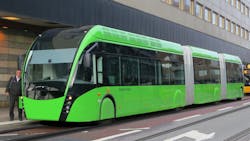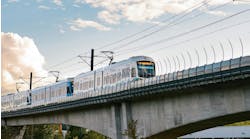Ultra Light Rail Claims Lower Risk and Lower Cost than Traditional Light Rail
The greatest advancements in technology happen when great inventions collide. The wheel gets paired with an axle. The computer with a cell phone. And now, in the case of public transit, quick charge electric buses, with on-off-rail technology. It's called Ultra Light Rail Transit (ULRT) and it's being presented as a lower risk, lower cost alternative to light-rail transit (LRTs). Simply put, ULRT uses electric buses on rails, with a few tweaks, that give it the potential to disrupt the way transit is built.
But how can this be? New technology can be wrought with risk,, expensive, packed with more computers, more autonomy, more software and more cost. So, it seems unreasonable that new technology can be lower risk.
But ULRT claims are extraordinary: fast construction, low cost, BRT reliability, LRT performance and the smallest carbon footprint. The upside of these claims could change how people move in the 21st Century, so it is time to revisit how public transit assesses risk.
The simplest definition of risk is 'the possibility of loss' and by that definition, one can make a compelling case for ULRT to be lower risk than LRT. ULRT proponents reason the degree of risk, reduced by lower cost and shorter construction time, exceeds the degree of risk assumed by it being a new approach to transit design and construction.
ULRT's method of drastic cost reduction is described below. Once informed of the approach, it's reasonable to accept the cost reducing features and benefits of ULRT as self-evident. Less cost is less risk. Less complexity is less risk. Less construction time is less risk. In the final accounting, the financial risk avoidance is undeniable and demands attention. At a typical construction cost of $15 million/mile, inclusive of design, engineering, construction, vehicles and equipment, it’s estimated that $1 billion can construct 66 miles of system. That's the game changer. Why construct a line when you can construct a system.
Regarding cost, established experts in transit and major infrastructure construction may consider $15 million/mile an unrealistic claim. However, ULRT's approach is so simple it doesn't qualify as major infrastructure. The less-is-more philosophy of the design is an understatement that fails to convey the impact of the new approach. ULRT uses much less, yet delivers much more, challenging the complexity of LRT systems that require a decade or more to construct, rarely meeting multi-billion-dollar budget goals by the time they are in operation. Proponents of ULRT contend LRTs, by virtue of their high cost and long construction time, carry unnecessary intrinsic risk.
The less-is-more design philosophy crushes cost, starting with the many benefits of lighter quick charging electric buses that use hybrid capacitor/batteries for energy storage. These vehicles fit existing bus routes without the need to add catenary wires or concrete rail foundations, eliminating most of the engineering and construction time needed for LRTs. By avoiding this complexity and speeding construction, ULRT doesn't reduce risk as much as avoid it altogether.
The benefits of lighter weight vehicles are many and key to simplified construction. They allow for rails on helical piles, which are installed on existing roadbeds or bare ground, minimizing the need for excavation while avoiding underground utilities and obstructions. Rail installation involves drilling these piles at engineered locations, then leveling and binding them with cross links that act like the web of a truss. Adding the rails, the assembly becomes a laying down truss with absolute location and a service life far exceeding concrete in cold climates. The road is finished with a top layer of asphalt, aligned with the tops of the rails, so the ULRT can share its lane with vehicular traffic, or not. This process makes the claim of laying 1/4 mile of rail per site-crew per day realistic. It follows that minimizing the disturbance of existing infrastructure and underground excavations reduces potential for delay, exposure to uncertainties, unknown costs and risk.
Installed rails present a minor disturbance as a 12-inch by 1-1/2-inch deep steel trough. This is easily traversed by all vehicle types. The rails are a unique profile that supports on-off-rail technology, eliminating the need for switches. The concept of a bigger diameter tire for the road, outboard of a smaller diameter steel wheel for the rails, seems too simple. Where an LRT requires a switch, ULRT drives off the rails and aligns with a different rail set. Eliminating switches drastically improves system reliability in cold climates and makes ULRT capable of using existing bus stations and maintenance sheds as the vehicles operate on existing asphalt surfaces. The patent-pending design reduces cost, complexity and risk.
ULRT's on-off-rail technology makes it immune to total system shutdown. All vehicles are independently operational on the system. If another vehicle breaks down, there is an on-track obstruction or the trough fills with ice or sand, the ULRV tire assumes the rolling load and the ULRV goes around or over the obstruction, without delay. Therefore, there is no risk of failure of the on-off-rail technology because the backup is tires. The 'new' on-off-rail capability can be said to reduce risk when compared to an LRT.
Unfortunately, rails are a safety hazard, unwelcome to vehicular traffic and pedestrians and crossing them at intersections poses a hazard. To minimize risk of contributing to accident or injury, ULRVs traverse major intersections on their tires, allowing the rails to disappear. Once past the intersection, the rails reappear and the ULRV resumes operation on the steel rails. That means ULRV is the only railed system that is as reliable and unobtrusive as a bus at intersections, reducing risk relative to an LRT.
Catenary wires can be a burden to any transit system. Without electric buses, they were an absolute necessity. With electric buses, the future can be catenary free. But, electric buses place demands on the grid that require extensive engineering and infrastructure updates. Operators are budgeting hundreds of millions for electric bus fleet charging sheds. Meanwhile the grid is planning substations to feed them. The ULRT less-is-more approach has a viable and ready solution for this by using quick charge technology, which is already available from a number of electric bus suppliers. With quick charging arranged in a daisy chain, vehicles that have a full charge range of 200 miles get charged at four- to five-mile intervals. This allows for infinite range on route. Because the vehicles consume electricity in small regular draws from the grid, and from chargers all over the city, the consumption is readily accommodated by the existing grid infrastructure.
There is a belief the tried-and-true ways of constructing light-rail transit are untenable. The too high cost and too long construction have, over time, been normalized by the lack of a viable alternative. At a cost of $15 million/mile and with arguably less risk associated from the less-is-more approach, ULRT is worthy of serious attention before a cool billion or two are spent on an LRT.

Steve Ostrowski | CEO, Municipal Transit Solutions Inc.
Steve Ostrowski is a fluid power and robotics engineering technologist. He's designed automation equipment, shock absorbers, plastic folding structures, Class 1 medical devices, retractable roof systems and on-off rail technology for public transit systems. He has advanced most of those industries with designs that challenged established practices with better solutions at lower cost. He has personally experienced the limits that paradigms impose with overexposure to a problem and proactively changes industries to maintain his objective approach to creative problem solving.

